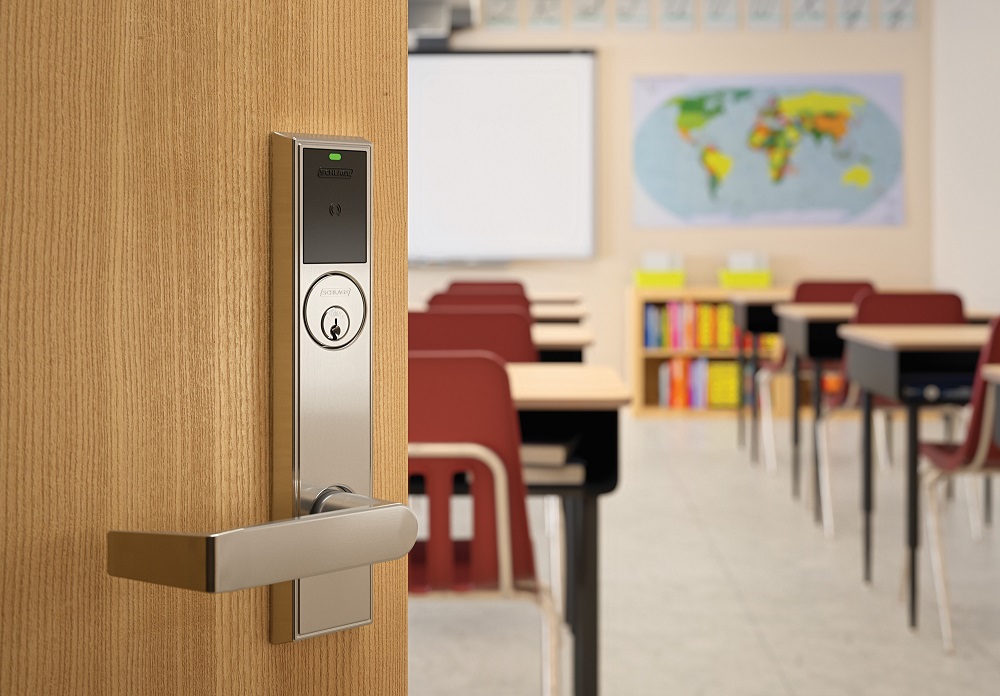Securing K-12 school buildings is a critical responsibility for facilities managers. With increasing concerns about school safety, implementing electronic access control (EAC) systems has become a best practice. A layered security approach, starting from the outside and moving inward, is recommended to ensure comprehensive protection. This method enhances security and allows for phased implementation, making it manageable and cost-effective.

There are three key areas where EAC can significantly enhance school security: perimeter entrances, higher security interior doors, and classrooms. By focusing on these areas, you can effectively safeguard K-12 buildings, ensuring a secure environment for students, staff, and the broader community. Additionally, as a facilities manager, your role extends beyond installation; it includes fostering a culture of security awareness and ensuring everyone understands and utilizes these systems to their fullest potential.
1. Perimeter Entrances
Securing the perimeter of a school is the first line of defense against unauthorized access. Implementing EAC at doors that open to the outside of the building is highly encouraged. This ensures that only authorized individuals can enter and acts as a deterrent to potential intruders. The Partner Alliance for Safer Schools (PASS) guidelines recommend securing perimeter entrances as a critical component of school safety.
Start by securing the most vulnerable points of entry, including main entrances, side doors, and other access points that lead directly into the building. EAC isn’t always necessary at every perimeter door; be selective and work to identify the highest-risk access points. To keep implementation manageable, begin with high-traffic openings and gradually expand to cover more areas.
EAC systems can be controlled from a central location, reducing the need for physical presence at each door. This centralized control can integrate with alarm systems, surveillance cameras, and emergency response protocols. In an emergency, designated personnel can initiate a lockdown with the push of a button, securing all connected doors instantly.
Establishing system access rights is crucial. Tailored access rights to the roles of staff members ensures that only those responsible for responding to emergencies, such as school resource officers (SROs), safety personnel, and designated administrators, can control the EAC system. Maintaining audit trails of who accessed the system and when provides accountability and traceability, crucial for security audits and incident investigations.
Credentials can be issued, modified, or revoked in real-time, reducing the risks associated with lost or stolen mechanical keys. Access logs track who accessed which doors and when, providing a clear record for security audits. You may also customize who can access certain doors. EAC systems also provide real-time alerts if a door is left open, propped, or forced. Specific doors can be programmed to lock and unlock following a schedule, reducing the need for manual intervention.
2. Higher Security Interior Doors
Certain areas within a school, such as administrative offices, network infrastructure rooms, nurses’ offices, or chemical storage, require higher levels of security due to the sensitive information and equipment they contain. Implementing EAC systems in these critical areas provides increased control and protection, ensuring compliance with regulations like the Family Educational Rights and Privacy Act (FERPA) and the Health Insurance Portability and Accountability Act (HIPAA).
EAC systems also offer valuable data collection and analysis capabilities. Detailed audit trails maintain records of access, providing accountability and aiding in investigations. By analyzing usage patterns, facilities managers can identify unusual or suspicious behavior and receive maintenance alerts for system malfunctions or low battery warnings.
EAC can also be used to control access to locations prone to student mischief, such as locker rooms or secluded hallways. By restricting access to these areas, facilities managers can help reduce incidents of vandalism, theft, bullying, and other misconduct.
3. Classrooms
Implementing EAC for classrooms provides several critical benefits. Remote lockdown capabilities can secure classroom doors instantly during emergencies, enhancing student and teacher safety and providing peace of mind. Administrators can monitor the status of all classroom doors in real-time, ensuring they are secure and quickly addressing any issues that arise.
While EAC can significantly increase classroom security, implementing it across all classroom doors can be cost-prohibitive. A balanced, layered approach, with EAC at the perimeter and high-quality mechanical locks on classrooms, can enhance safety while spreading costs over time. This makes it more feasible for schools to implement comprehensive security measures gradually.
Mechanical locks should meet industry-recommended best practices and parameters to ensure they provide adequate security. Using high-quality, durable locks that meet industry standards, along with regular inspections and maintenance, helps ensure they function correctly. Staff must be trained on how to use all types of locks effectively.
Cost and funding are significant challenges in adopting EAC. Developing a long-term plan that includes phased implementation of EAC can help spread costs over several years. Additionally, schools can explore federal and state grants available for security improvements to support their efforts. With strategic planning and utilization of available resources, facilities managers can implement EAC to enhance classroom security effectively and sustainably.
Key Considerations When Implementing a Long-Term Strategy
When implementing a long-term EAC strategy, it’s essential to choose products that are compatible with current and potential future technologies to avoid obsolescence and costly replacements. Selecting vendors that offer robust support and regular updates ensures the system remains effective and up to date. Aim for a unified security platform that integrates EAC with other security systems, such as surveillance, alarms, and emergency communication. Ensuring that all components work together seamlessly provides comprehensive protection and simplifies management.
Additionally, plan for future expansion and adaptation as technology changes, ensuring the system can grow with the school’s needs. Provide comprehensive training for all users to ensure they understand how to operate and manage the system effectively. Advocate for the development of policies regarding access control and security protocols to standardize procedures across the school.
A layered security approach, combining EAC with other measures, provides comprehensive protection. Start with high-priority areas and expand over time to ensure a safe learning environment. By taking proactive steps, especially the implementation and education on use of the systems, you can help create a more secure atmosphere for everyone in the school community.

Melany Whalin is the demand generation manager for vertical markets at Allegion US. With 18 years of experience in the safety and security industry, Whalin also holds an MBA from Indiana Wesleyan University.
